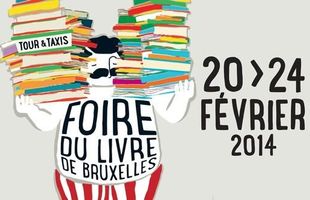The literary evening got underway against an unusual
background: that of the honking of horns and jubilant cheering as Belgium
celebrated a World Cup victory on the streets of Brussels outside. Inside, journalist
Laure Adler quipped to the packed hall how touched she was that so many people
had turned up to listen to her on the same evening as a national football match.
The Frenchwoman had her Belgian audience on side and didn’t
lose them for the duration of her interview about the life and work of the
French writer Marguerite Duras, who would have been 100 this year.
Adler, whose 1998 biography of Duras has been
reprinted this year, explained how she found Duras to be a writer who pushed the boundaries not
only in literature but also in cinema and theatre. Duras is a writer she admires greatly and with whom she has identified ever since reading
Un barrage contre le
Pacifique at a particularly low moment in her life. Duras was also
a writer who Adler had the opportunity to meet on several occasions.
Not everyone has always been so admiring of Duras. Adler mentioned
the intellectuals Duras hung around with, many of whom mocked her. In fact, when Adler first approached Gallimard with her idea for a
biography of Duras, the response was “You’re mad! No-one is interested in
that!”
But Gallimard did publish Adler’s biography and in the
intervening years has reprinted Duras’s works in its Folio paperback
editions, opening the author up to a new generation of young readers. In China,
the author of The Lover and Hiroshima mon Amour is the most read foreign writer!
Back to the drawing
board
Adler’s biography on Duras took a while to see the light of
day, not least because no sooner had she finished her first draft than Duras
entrusted her archives to the Institut Mémoires de l’Édition Contemporaine
(IMEC), providing a mass of new source material for the biographer. Adler threw her 700-odd pages
straight in the bin and made a fresh start.
If the tales that Adler touched on during her public
interview in Brussels this week are anything to go by – Duras’s childhood in
Vietnam, her World War II experiences in France, her marriages and affairs, her
alcoholism, her relationship with her French teacher mother and her absent
father…- the story of the writer’s life almost sounds like a novel in itself.
The evening's interview
was interspersed with readings of Duras’s work as well as audio clips of Duras
herself speaking, with images of the late author projected on two large screens
throughout. The event, organised by Brussels’ international literature house
Passa Porta,
provided a fascinating insight into a woman whose work I first studied on a
film course at university. Given
that it’s her centenary year, maybe this is the year to revisit her work; there will certainly be plenty of opportunities to do so.
 |
|
Copyright Bellone 2011-2014
|
I cannot wrap up this post without
mentioning the venue of this week’s event:
La Bellone.
What a wonderful architectural discovery in the centre of Brussels! From the
main street (Rue de Flandre 46) the building isn’t particularly striking, but
enter and the main corridor opens on to a covered courtyard dominated by a
magnificent 17
th century façade. Built by Cosyn, the same architect
who designed the Maison des Boulangers (Roi d’Espagne) on Brussels’ central
square, this hidden gem is today a listed building.










